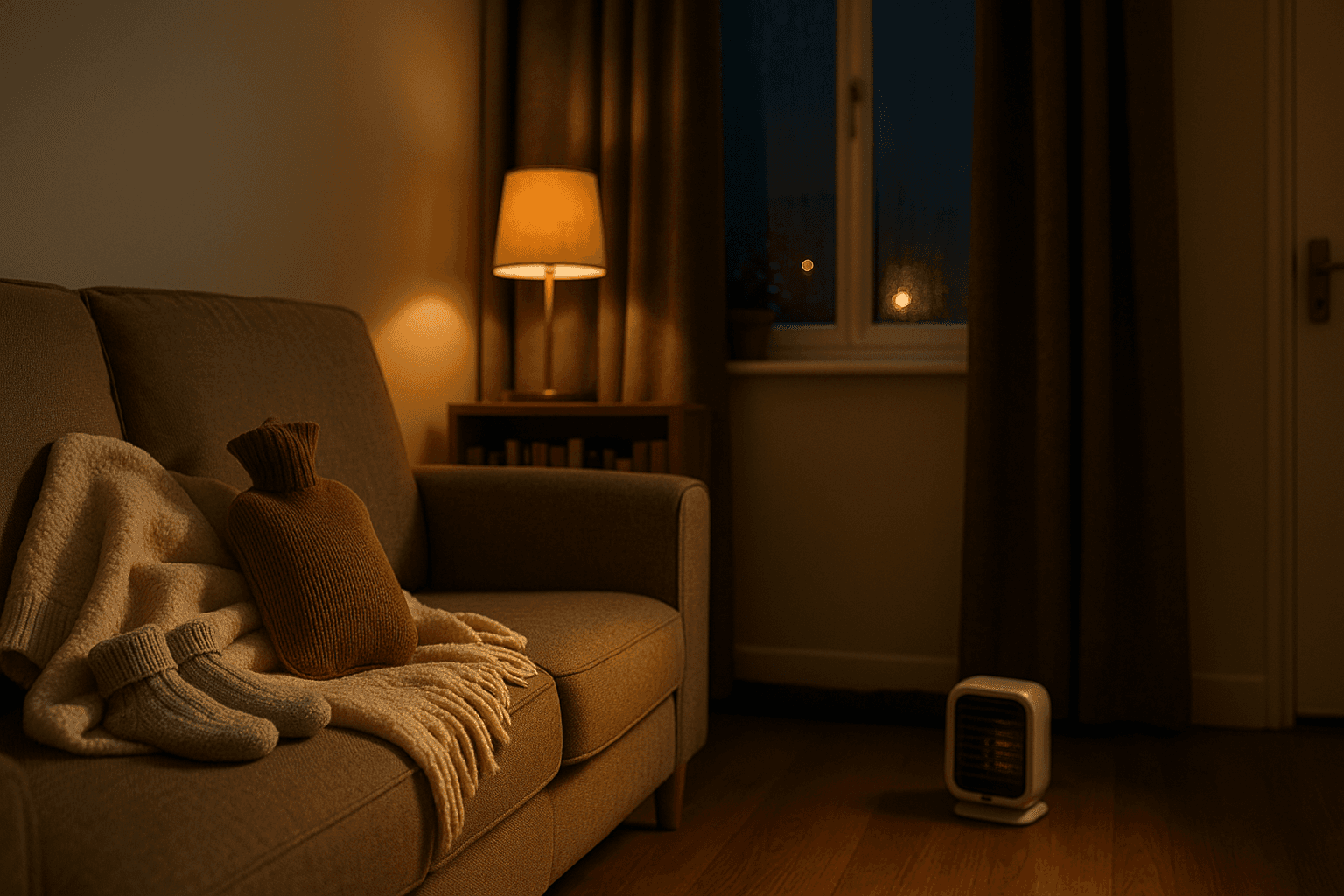
Stay Warm, Spend LessEnergy-Saving Comfort Picks
Drafts, single glazing, radiators under windows—classic UK rental. Here’s a fast, reversible setup and a few comfort buys that heat you, not the whole street.
Get the 30-minute warmth checklist (PDF) + monthly UK-rental comfort tips.
Zero spam. Unsubscribe anytime.
Reversible
Peel-and-stick seals, clip-on liners—no drilling needed.
Small-zone heat
Warm your hands/feet/sofa zone instead of the whole flat.
Budget-first
Fix drafts before spending on higher wattage devices.
You don’t need major works to feel warmer. Start with the biggest leaks, then layer textiles and personal heat. Below is a 30-minute plan, proven picks, room checklists, and clear running-cost examples.
Warmth in 30 Minutes (Landlord-Friendly)
- Front door: Add adhesive weatherstrip where you see daylight. Draft snake or door sweep at the bottom.
- Windows: Foam seal the worst gaps. At night, close trickle vents (if safe) and pull thermal curtains/clip-on liners.
- Zoning: Shut doors to unused rooms—smaller air volume is easier to keep warm.
- Personal warmth: Pre-warm bed/chair with a hot-water bottle or heat pad; keep a fleece throw by the sofa.
All steps are reversible when removed slowly; test a small area first to protect paint/frames.
Blueprint: seal entry, treat windows, close off spare rooms, pre-warm where you sit/sleep.
Comfort picks that punch above their weight
Clear disclosures; affiliate links may earn us a small commission at no extra cost to you.
Self-adhesive draft excluder seals
Removable, paint-safe when peeled slowly. Treat door frames and window sashes first.
See options →Thermal blackout curtains / clip-on liners
Reduce radiant loss at night. Aim for full frame coverage with light overlap to the floor.
See options →Hot-water bottle or microwave heat pad
Warm the body directly. Use hot—not boiling—water; check bottle yearly for wear.
See options →Low-watt personal heater (desk/sofa zone)
Heat a 0.5–1.5 m radius instead of the room. Safer when tip-over protection is included.
See options →Door sweep / draught snake
Blocks that icy floor-level jet under doors. Choose removable sweep or fabric snake.
See options →Thick socks + fleece throw
Textiles trap warm air around you. Keep within arm’s reach of your coldest seat.
See options →Room-by-Room Checklist
Entry & Living
- Door seal + draught snake; letterbox brushes where relevant.
- Thermal curtains that fully cover the frame (ideally to the floor).
- Personal heater by desk/sofa; close spare rooms to reduce volume.
Bedroom
- Pre-warm bed with hot-water bottle 10–15 minutes before sleep.
- Move bed off external walls if you can; avoid overhanging windows.
- Fleece layer/topper to reduce cold-sheet shock.
Drafts vs. Personal Heating — what to do first
Fix drafts first
- Less heat leaking means everything else works better.
- Seals, sweeps, curtains — the comfort jump is immediate.
- Usually the cheapest upgrade with the best ROI.
Then add personal heat
- Hot-water bottle/heat pad to pre-warm you or the seat/bed.
- Low-watt heater for a very small zone while working/reading.
- Use short sessions; never leave heaters unattended.
What does it cost to run a small heater?
Formula with your tariff: watts ÷ 1000 × price per kWh = cost per hour. Example uses £0.28/kWh for illustration—check your bill or smart meter.
| Heater | Watts | Example cost/hour | Best use |
|---|---|---|---|
| Personal desk heater | 200W | £0.06 | Hands/feet while working |
| Compact ceramic | 500W | £0.14 | Small zone by sofa |
| Typical fan heater | 1000W | £0.28 | Short bursts only |
Numbers are illustrative; focus on draft-proofing first, then use the smallest wattage that does the job.
Warm habits that cost £0
- Open curtains for daytime sun; close thermal curtains before dusk.
- Cook a one-pot dinner in the evening—ambient warmth lingers.
- Keep slippers + a throw next to your coldest seat so you actually use them.
- Close internal doors to limit airflow paths that steal heat.
Safety essentials (quick read)
Hot-water bottles
- Use hot, not boiling water. Replace the bottle if cracked or sticky.
- Wrap in a cover; avoid direct skin contact for long periods.
- Empty fully after use; store with the stopper removed to dry.
Heaters
- Keep clear of bedding/curtains; never cover grilles.
- Use on stable surfaces; prefer models with tip-over protection.
- Do not leave running unattended or while sleeping.
Related reads
Some links may earn a small commission at no extra cost to you. It helps keep community guides free.
Need tailored tips for your flat?
Send a quick note about your draft hotspots and we’ll reply with a 3-step plan.